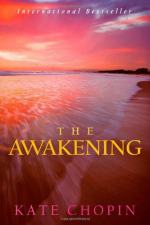|
This section contains 8,398 words (approx. 28 pages at 300 words per page) |

|
SOURCE: Radcliff, Douglas. “Literature of Deliverance: Images of Nature in The Awakening.” Southern Studies 1, no. 2 (summer 1990): 127-47.
In the following essay, Radcliff-Umstead explores the sociopolitical aspects of The Awakening as illustrated by Chopin's nature imagery.
Kate Chopin's novel The Awakening belongs to the nineteenth-century tradition of “literature of images” where description of nature relates to and advances the narrative's major themes and characterizations. The American novel shares with the works of authors like Chateaubriand, Balzac, Flaubert and Charlotte Bronte a similar emphasis on natural description as a primary instrument to express fundamental psychological and social conflicts.1 As a female author portraying the revolt of her heroine against a restrictive society, Chopin employs nature to illustrate the entrapment of women under patriarchy and their battle to achieve deliverance.2 Edna Pontellier, the protagonist of The Awakening, seeks to liberate herself from the traditional womanly roles of wife, mother or lover...
|
This section contains 8,398 words (approx. 28 pages at 300 words per page) |

|


